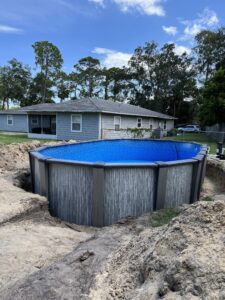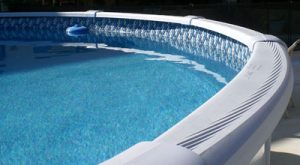Oval above-ground swimming pools aren’t easy to install. And in Orlando, there aren’t many installers with a lot of experience with them.
Although somewhat popular with wanting one in the greater Orlando area, oval-shaped AG pools are much fewer in number than round pools.
DURING THE SUMMER IN ORLANDO, GETTING AN INSTALLER FOR AN OVAL MAY BE TOUGH
Above-ground pool installers get very busy during the hot months in Orlando, which is typically about 8 months out of the year. And with round-shaped pools being easier to assemble, installers will choose to do those over ovals when busy.
DIY INSTALLATION OF AN OVAL ABOVE-GROUND POOL IN ORLANDO WON’T BE EASY
In many cases, pool owners choose to self-install their metal-walled oval pool. This is either to save the higher cost of having one installed OR they can’t find anyone in the Central Florida area to do it.
This will be a difficult DIY project for anyone regardless of construction experience. Especially if attempted during the hot summer.
THINGS TO KNOW ABOUT INSTALLING AN OVAL ABOVE-GROUND POOL IN ORLANDO
1 Engineering is not great
With now 37 years of pool installation experience, I can tell you that oval pools are not at all designed or engineered well.
It’s important to know this if you are self-installing one OR paying someone to install one. No part of an oval will go together perfectly and often they won’t look perfect when done regardless of who installs it.
2 Ovals have buttresses
You may buy an oval model that says “buttress-free” or “yardmore” in the description. But if the shape of the pool has straight sides, then it must have buttresses.
And buttresses take more space in the yard and have to be assembled.
3 The buttress structure goes in the ground some
If DIYing, don’t spend a lot of time smoothing out your earth before setting your bottom track. The buttresses usually have to be recessed some in the ground, so all of that work you do leveling and smoothing out the area will be a waste of a step.
4 Ovals can take more than a day to have installed
During the hot summer of Orlando, everything done outside (especially in direct sunlight) will take more time to do.
Although an experienced installation crew can usually get an oval done in a day, they may run into an issue and decide to finish it up the next day.
Do-it-yourselfers can expect to spend a few days installing an oval pool. Especially in the summer.
5 Semi-inground ovals need a bigger hole

Ovals have buttresses that stick out some on the straight sides of the pool. So, when installing an oval in a hole, extra space is needed to set and level these buttresses.
Finding out how far your model of oval buttresses stick out beyond the pool’s wall will allow you to dig the correct-sized hole for installation.
Depending on the model, buttresses can protrude out from the pool wall eight inches to three feet, three inches. This is a wide variation so it’s best to know before digging the hole.
NOTE: Most upgraded oval models for Wilbar pools need one foot, seven inches beyond the wall of the pool.
6 Ovals are easier to keep the wall up during the installation
One of the trickiest parts of installing an above-ground pool is rolling out and erecting the wall of the pool. Since oval-shaped pools have buttresses, they are already set in place and assembled together when the wall goes up.
So, when rolling out the wall in place, it can be secured well to the buttresses which will help it from falling down before you get it bolted together and completed.
7 Some will use extra sand
Since Orlando and Central Florida have mostly sand-based earth, additional sand is usually not recommended or required for an above-ground pool installation.
Since ovals have buttresses that are buried some in the ground, some will elect to have some extra sand to spread on top of the buttress structure and its water plates.
8 I recommend a liner guard with an oval-shaped pool
Since some metal parts lay directly underneath the floor of an oval pool, I recommend putting down a liner guard just in case something happens later with the pool’s floor.
A liner guard/pad isn’t much really, but it is a piece of cloth that can protect the liner from any of those metal parts if the earth between them and the liner moves or wash away.
